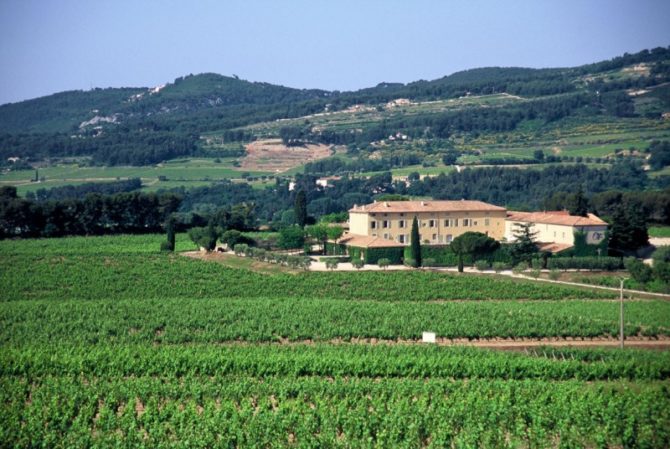Rosé de Provence

“Provence,” wrote Waverly Root many years ago, is “the most magical of all the provinces of France.” Then, in The Food of France, he promptly went on to prove his point. His descriptions of Provençal specialties, like daube de boeuf, brandade de morue, Cavaillon melons, ratatouille, all things garlicky—including soupe à l’ail and the pungent aïoli mayonnaise—and all things à la Provençale, which basically means with tomatoes, are still delicious reading. But, alas, Root was not concerned about wine. He offers a few lines about Châteauneuf-du-Pape, a few more on Côtes du Rhône and a couple of paragraphs about Provençal rosé. Compare this with his twelve pages on bouillabaisse. Now, I ask you…
From Avignon in the west to the Alpes Maritimes in the east, Provence is full-fledged wine country, with some 50,000 acres devoted to rosé wine. Sadly, for many years, even in Waverly Root’s time, most of Provence’s rosés have been mediocre plonk at best. Too many Provençal winemakers had their eyes on tourist hordes that every year flock into Cannes, Nice, Aix-en-Provence and Avignon, eager to drink whatever vile stuff the locals might serve up. Much of it was, and still is, cheap white wine of dubious provenance, tarted up with a bit of equally undistinguished red. What happened over the years was probably inevitable: the wine became associated with the people who drank it.
Rosé wines have improved immensely in recent years but even in the bad times, they had some fervent fans. The traditional Provençal rosé has always been Tavel, from a little town of that name just north of Avignon. A.J. Liebling, the storied New Yorker writer and world-class gourmand, loved the stuff. “Tavel,” he once said, “is the good, the old, and, as far as I am concerned, still the only rosé.” Who can argue with Joe Liebling when it comes to food or wine?
Well, me for one, at least where rosé wine is concerned. Liebling was a Francophile; the idea that some other sovereign nation might, on occasion, turn out a drinkable rosé, I’m quite sure never entered his mind. In fact both the Italians and the Spanish have been known to ferment a decent pink wine now and again, and the French outside of Provence are rumored to have done the same.
But I forgive Liebling his reckless pronouncement. Writing later in life, he was summoning up a time long gone, as roseate as the wine. In 1926, at the age of 22, he had been living in Paris as a student, supported by his father, a loving and infinitely patient furrier in New York. And as young men loose in Paris have long been wont to do, he regularly ran out of money. This caused him to trudge frequently across the Seine from his Left Bank haunts to the Boulevard des Italiens where his monthly stipend, 200 francs, as often as not had yet to turn up at the Crédit Lyonnais.
When he stopped en route for lunch, usually at a bistrot called the Beaux-Arts in the Rue Bonaparte, he studied the menu with care. His pockets empty and his credit gone like François Villon’s snows of yesteryear, he confined himself to the cheapest offerings, like paté maison at 75 centimes, and his frequent friend in poverty, the Tavel rosé. “The plain Tavel came to the table in a bottle with a blue wax seal over the cork,” he recalled, “the supérieur in a bottle with a purple seal. The plain Tavel cost 3.5 francs, the supérieur two centimes more a pint.”
Liebling, who went on to become a superb writer and a chronicler of upscale eating and drinking, was ahead of his time when it came to rosé. Here in Paris, in New York, and wherever else wine drinking is serious business, rosé is now booming. Currently, rosé constitutes a fifth of all the wine sold in France, where it has overtaken white wine in sales. In the United States, according to a Nielsen survey, rosé sales grew 53 percent in 2007.
Good rosé wines, as opposed to those cheap white and red blends, are made from the same traditional grape varieties that are used to make the best red wines of Provence and the Rhône Valley: grenache, carignan, syrah, mourvèdre and cinsault. Their skin is red, their juice is white. To make red wine, after the grapes are crushed the skins are left in the fermenting vats with the juice. To make rosé, the skins remain in the mix for a shorter time—the best rosés are usually made by separating the grape skins from their juice fairly quickly.
Some rosés are made by bleeding off part of a tank of red wine when it is still fermenting. This provides some rosé wine, and also serves to concentrate and deepen the remaining red.
Slowly, these well-made Provence rosés are rising above the tawdry reputation of the cheap, high-alcohol blends of yore. There were always a few dedicated winemakers in the region, like the Domaine Ott, whose superb but overpriced rosés have long been found in fine restaurants all over France. Now they are being joined by newcomers like the Domaine Lafond and the Domaine de la Rocalière, both from Tavel. Were he still around, Joe Liebling would greet Pascal Lafond’s delightful rosés with tears in his eyes, and not just because they are Tavels. They are luscious, bright and lively; worlds apart from the everyday stuff of beachside bistrots. Another prestigious Tavel producer is the Domaine Perrin, known the world over for its Châteauneuf-du-Pape.
The Domaine de Triennes, run by some prominent Burgundy winemakers, produces a rosé called Gris de Triennes, a wine with character and a delightful bouquet. The Domaine Tempier is another producer of a quality rosé, and other fine rosés come from the Commanderie de la Bargemone in the little town of Saint Cannat in the Bouches-du-Rhône. Even the Ile de Porquerolles, a small island in the Mediterranean southeast of Toulon, is producing worthy rosés, with La Courtade one of the better labels.
One of the more interesting new Provençal rosés comes from the country around Draguignan, in the Var, where Sacha Lichine, son of the legendary wine writer and Bordeaux wine grower Alexis Lichine, has taken over an old property, the Château d’Esclans, in the village of La Motte-en-Provence and, from the château’s own vineyards, has begun to produce some of the most talked about wines on the Côte d’Azur. His top-of-the-line rosé, Garrus, had caused a sensation. At about €80 a bottle, it’s the most expensive of all rosés. Who drinks it? According to Mr. Lichine, customers for Garrus include yachtsmen—and women—who ply the Mediterranean out of Cannes and St. Tropez and who are always eager for something new and exclusive. Château d’Esclans wines are made by Patrick Léon, who once worked for Lichine’s father and was, for more than 20 years, winemaker at Château Mouton Rothschild in Bordeaux.
Mr. Lichine hastens to note that there are other Château d’Esclans rosés, starting a €14 for one called Whispering Angel, priced for enthusiasts who do not presently own yachts.
Recently, the European Union tossed a large political rock into the placid waters of the blossoming rosé wine business. The EU wants to legitimize the blending of red and white wines to make rosé, in a frank attempt to unload oversupplies of both, particularly from Spain and Italy. The Provence Wine Council, which represents all the region’s wine producers, is unalterably opposed to the EU initiative. The EU will vote on the blending technique on June 19th. If approved the blending procedures could begin as early as August 1.
Share to: Facebook Twitter LinkedIn Email
Leave a reply
Your email address will not be published. Required fields are marked *



